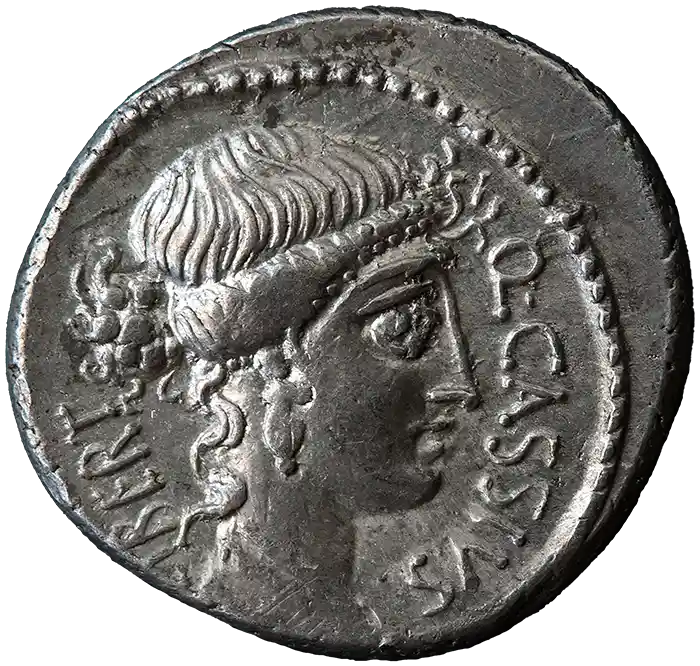Roman Republican
Q. Cassius Longinus AR Denarius
- - - - - - - - - - - - - - - - - - - - - - -
This coin is another commemorative one for the Trial of the Vestal Virgins.
- - - - - - - - - - - - - - - - - - - - - - -
VESTA VARIANT
Other coins show a veiled head of Vesta and ‘Q • CASSIVS - VEST’ on the obverse.
THE STANDING FIGURE
Some identify the standing figure on top of the temple as the goddess Vesta, although the 'sceptre and patera’ appear in many other coins depicting different gods or even the emperors / their families.
FLAMES OR A GRIFFIN?
Some descriptions see the antefixes as griffin heads, although usually there’s no specific description of them. To me they resemble flames, like the eternal one in the temple.
THE CURULE SEAT
In Ancient Rome, the curule chair (sella curulis, probably from currus, “chariot”) was the seat upon which magistrates holding imperium were entitled to sit. It was a seat of power, and it was either present in the temple, or depicted as a symbol of the consul Longinus Ravilla.
THE VOTING URN AND THE BALLOT (TABELLA)
The voting urn on the left and the tablet (tabella) on the right are a further reference to the trial. The ballot is inscribed with the letters 'A' for 'Absolvo' (I acquit) and 'C' for 'Condemno' (I condemn), referring to the Vestal Virgins.
THE PALLADIUM
The Temple of Vesta saw many modifications through the years. It used to keep one of the most sacred objects of Ancient Rome: a statue of Pallas Athena, called the Palladium (Greek Παλλάδιον (Palladion)). It was said to have been stolen by Odysseus from Troy, and later brought to Rome by Aeneas.
Romans believed that the safety of Rome and its power depended on the safety of the Palladium and a few other sacred objects, called pignora imperii ("pledges of rule"). They were:
- The Cybele stone
- The quadriga of Veio
- The ashes of Orestes, son of King Agamemnon
- The sceptre of Priam, last king of Troy
- The veil of lliona, Priam's suicidal daughter
- The Palladium, i.e. the sculpture made by Athena for her friend Pallas
- The Ancilia, i.e. the 12 bilobed shields of the Salian priests, only one of which was the original - sent by Mars Gradivius to King Numa Pompilius as a pledge of Rome’s eternal invincibility.
THE TEMPLE THROUGH THE YEARS
The first Temple of Vesta was built by Numa Pompilius, the second king of the Roman Kingdom. He also built the original Regia ("king's house") and the House of the Vestal Virgins, and founded the priestly order of Vestal Virgins. The temple was destroyed and rebuilt many times.
The first destruction of the temple was by the Gauls in 390 BC. According to Ovid, the second destruction in 241 BC may have started because of the fire in the temple itself. During the fire, the Vestals were unable to collect the cult objects, and they were destroyed along with the Temple of Vesta. Lucius Caecilius Metellus, the Pontifex Maximus at the time, went into the burning temple to save the palladium. He was blinded by the flames, and it was believed that this was the result of him breaking the tradition of the temple which barres men from entering.
Fires also occurred again in 210 BC and again in the early first century BC. The temple was rebuilt again during the reigns of Augustus and Nero. Finally, it burned down in 191 AD and was rebuilt for the last time during the reign of Septimius Severus by his wife, Julia Domna.


